|
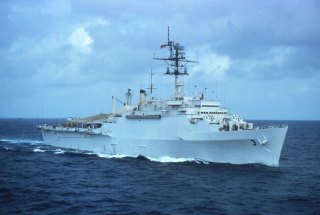
This shows the USS LaSalle (LPD-3), which served as the flagship for
our Persian Gulf operations. She was specially configured for
this role with additional air conditioning, a covered hangar for parking
her helicopters and the only American warship painted pure white!
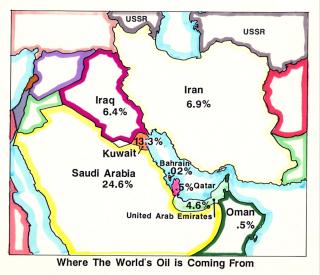
Chart showing the respective share of the world’s crude oil that
emanated from Persian Gulf states in 1987.
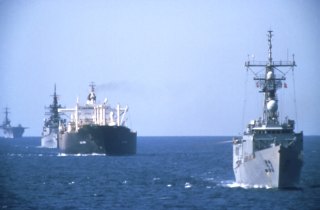
In July 1987 President Reagan announced Operation Earnest Will, whereby
the United States re-flagged merchant ships bound for Kuwait so they
could transit the Persian Gulf in convoys under our protection, as shown
here. A major part of that effort involved P-3 Orions based out
of Saudi Arabia providing clandestine patrol coverage. One of
my first assignments at TTT was to spool up our patrol aviation aircrews
engaged in this specialized surveillance work.
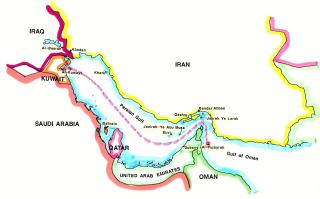
Generalized map showing path of our Earnest Will convoys to Kuwait,
through the Straits of Hormuz.
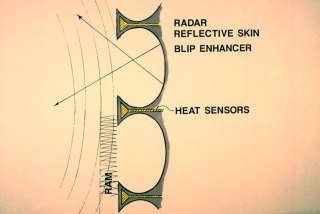
During the reflagging operations I developed some low-tech concepts
for passive defense measures that might be employed on the hulls of
our warships where their radar cross section was maximum, in order to
“lure” sea skimming missiles.
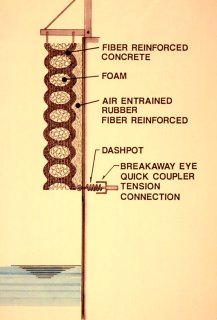
The concept I liked best utilized Kevlar-fiber reinforced foam encased
in fiber-reinforced concrete baffles, like that shown here. The baffle
would be lashed to the hull in the amidships area, similar to how German
panzerkorps tack-welded tracks to the vulnerable parts of their tanks
during World War II. The idea was to provide additional lightweight
armor which could absorb the explosive energy of a cruise missile warhead;
hence the emphasis on being highly compressible with high tensile strength.
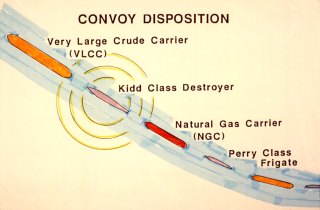
Before mines could be swept from the Gulf, we placed the largest vessels
at the head of single-line convoys, as I sketched here for briefing
our aircrews. This array was humorously referred to as "the Polish
minesweeper" (put the biggest guy in front and hope he survives
the detonatation).
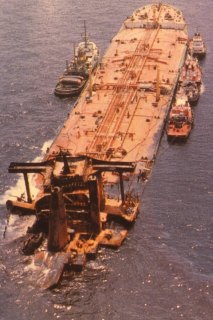
On Friday July 24th, two days into Earnest Will, the 415,000 ton oil tanker Bridgeton struck
an Iranian mine. Four of the ship’s 31 compartments were
breached. This views shows the Liberian-flagged tanker Stena Explorer, which struck an Iranian mine on June 19th. She had about 120 feet of hull beneath the water in this
view; a remarkable testimony of how difficult it is to sink a super tanker.
Between May 16th and July 25, 1987 five super tankers struck mines in the Persian Gulf, hastening the deployment of HM-14 and their minesweeping
choppers to the area!
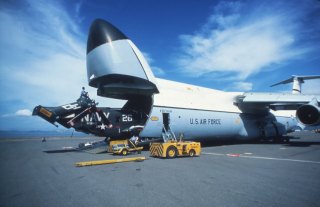
Federal Express, military style: the plethora of dangerous sea mines
floating around the in the Persian Gulf necessitated mine countermeasures
by the Navy. In order to get our behemoth RH-53D helicopters to
the Gulf quickly, they were loaded on C-5 Galaxy transports and flown
in.
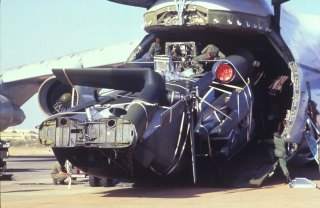
The unloading of the RH-53s was like watching a butterfly hatch from
a cocoon. The '53s are the largest helicopters in the military
inventory, capable of carrying 70 men!
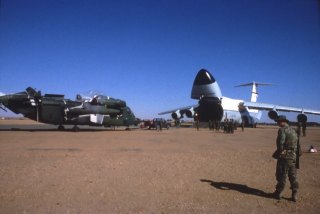
Here is another Super Jolly Green MH-53 chopper being rolled onto the
sands of Saudi Arabia just after being unloaded from a C-5. The
folding mechanisms are a standard aspect of naval aircraft so they can
be stowed aboard aircraft carriers.
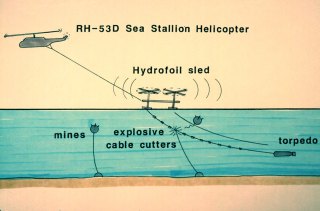
When the first contingent of minesweeping helicopters arrived this was
the basic sweeping scheme that was employed in the main shipping channels,
using RH-53Ds.
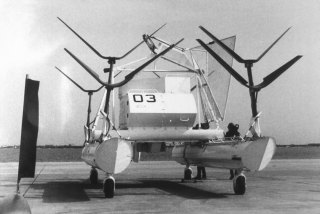
Mk 105 Magnetic Sweeper which was towed by the RH-53Ds. It becomes
foil-born at a sped of about 13 knots. It is typically towed about
450 feet behind the chopper at a speed of between 20-25 knots.
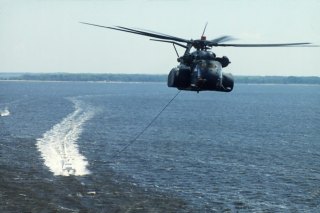
This view shows the more powerful MH-53E Sea Dragon, designed to pulling
the much heavier Mk 166 hydrofoil magnetic sweeper. These began
deploying to fleet units in 1987, but the Mk 166 sled was subsequently
abandoned. Choppers can cover a whole lot of ocean quickly.
Conventional minesweeping vessels eventually reached the Gulf and were
critical to our efforts, collecting the deadly mines, doing intel on
them, and then disposing of them.
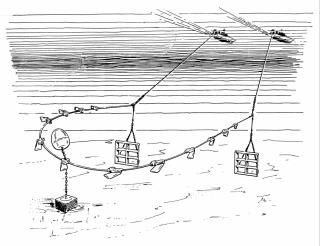
Sketch illustrating how conventional minesweepers work in pairs or singly
to sweep mines tethered to the sea bottom.
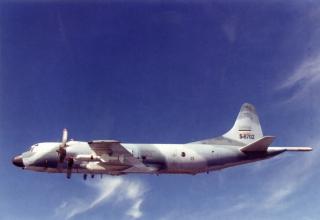
It seems like everyone flies P-3s. This shows an Iranian Air Force P-3F
whose crews were trained at NAS Moffett Field before the Shah of Iran
abdicated in January 1979. Many of us had close friends that were
Persian, from school and military service associations.
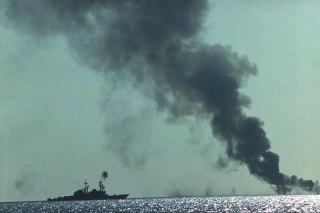
Armed Iranian offshore oil drilling platform in the Persian Gulf being
shelled by one of our Spruance class destroyers in April 1988 in retaliation
for the USS Samuel B. Roberts striking an Iranian mine about 65 miles
east of Bahrain.
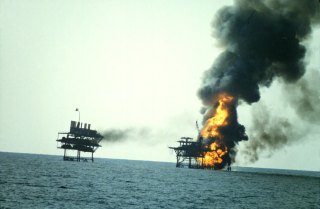
Burning Iranian oil platforms in the Sirri and Sassan oil fields, shelled
during Operation Praying Mantis on April 18, 1988. Our SEALs tried
to board the burning platform, but could not because of the intense
heat. It was believed that Iranian Boghammar patrol boats had
sortied from these platforms attacking our convoys at night.
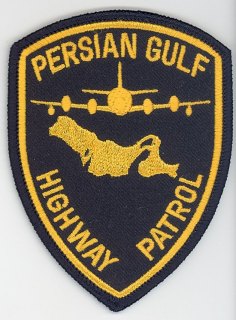
Soon after we began staging P-3s in the Persian Gulf to fly nighttime
patrols, patches began appearing, like this Persian Gulf Highway Patrol.
Despite the humor, our patrol planes were attacked from time to time,
mostly by small caliber fire from Iranian oil drilling platforms and
Boghammer patrol boats operated by the Iranian Guards.
Questions
or comments on this page?
E-mail Dr. J David Rogers at rogersda@mst.edu.

|